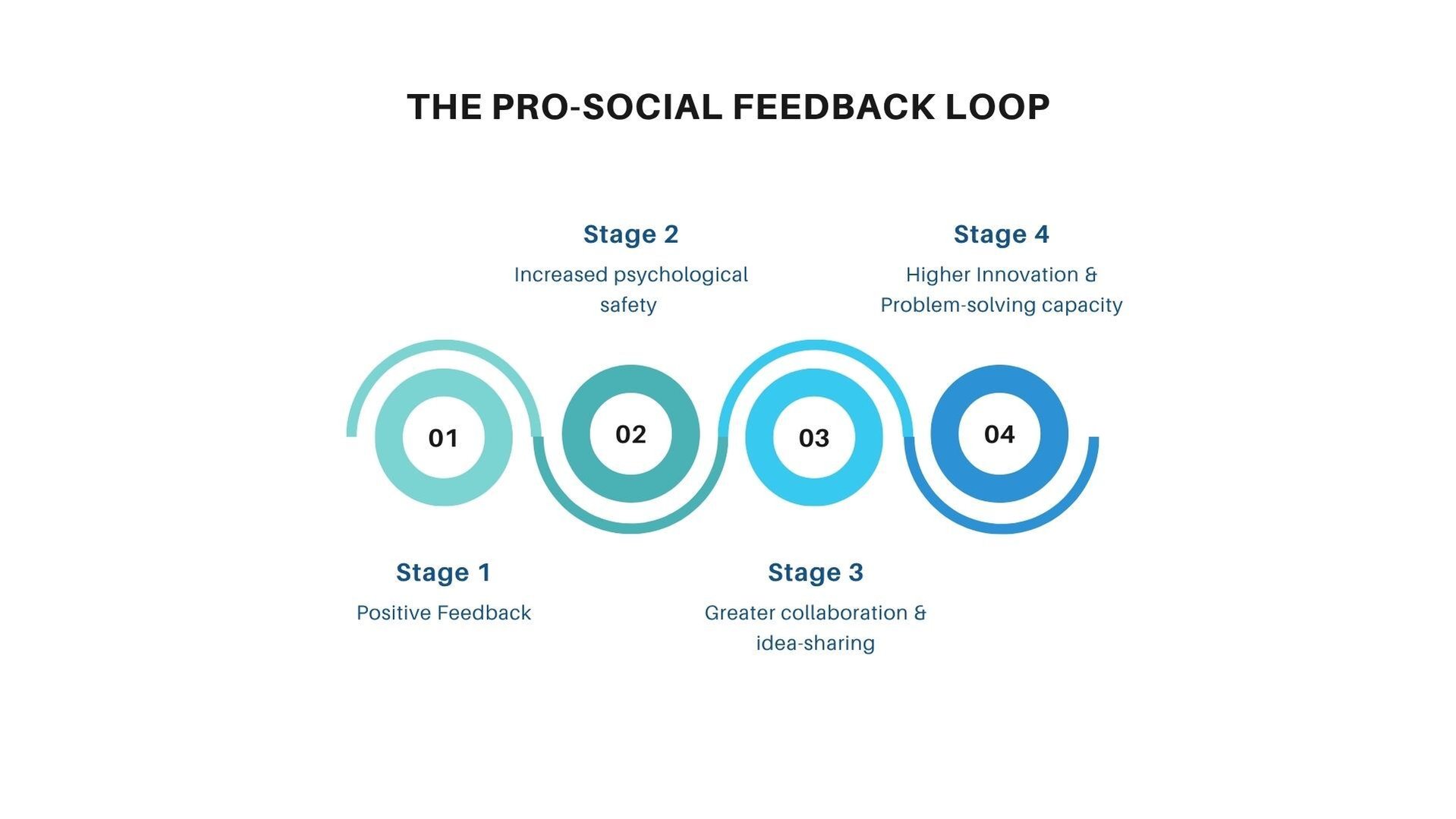Why Positive Employee Feedback is so important
Imagine an environment where employees regularly hear what they’re doing right, where recognition flows naturally from manager to team member, and peer to peer. That kind of culture isn't built overnight, but it starts with one powerful tool: positive employee feedback.
In hybrid and often fragmented work environments, feedback is more than just a performance tool. It’s a communication lifeline. According to Twesme et al. (2021), feedback directly impacts motivation, especially when it’s delivered constructively and frequently. Moreover, a study by Kate Walker (2024) found that positive reinforcement contributes significantly to organizational commitment and job satisfaction.
So, let’s dive into how you can use this simple yet powerful tool to uplift your teams, improve communication, and drive better results.
Table Of Contents
- What is Positive Employee Feedback?
- The Science of Positive Feedback
- The Ripple Effect: How Positive Feedback Impacts Teams & Culture
- The Role of Positive Feedback in Remote and Hybrid Work
- 16 Positive Employee Feedback Phrases to Use Today
- Building a Habit: Embedding Positive Feedback into Daily Culture
- Micro-Habits for Managers: Small Changes, Big Impact
- Peer-to-Peer Recognition: Bottom-Up Culture Builders
- How Empact Makes Positive Feedback Easy and Scalable
What Is Positive Employee Feedback?
Positive employee feedback is any recognition or communication that reinforces a person’s effort, skills, or behavior in a constructive and uplifting way. It can be formal (performance reviews, 1:1 meetings) or informal (a quick chat message, a shoutout in a team meeting).
Unlike constructive feedback, which aims to correct or guide, positive feedback is meant to affirm and motivate. It helps employees understand what they're doing right and encourages them to keep it up.
An example:
A remote employee proactively solves a technical issue affecting a cross-functional team.
How to address:"Thank you for stepping in so quickly to resolve the integration bug last week. You not only prevented a delay for the marketing team, but your detailed walkthrough helped others understand the fix and avoid similar issues. That kind of initiative and knowledge-sharing makes a huge difference."
Why it works: This feedback is timely, specific, and impact-driven. It reinforces proactive problem-solving, acknowledges cross-team collaboration, and encourages knowledge-sharing.
The Science of Positive Feedback
Why does positive feedback have such a powerful impact on people and teams? The answer lies in the rewiring of our brains:
When we receive genuine recognition, our brains release dopamine, a neurotransmitter associated with pleasure, motivation, and learning. This “feel-good” chemical not only boosts our mood in the moment but also reinforces the behaviors that led to the praise in the first place. In other words, positive feedback literally helps “rewire” our brains to repeat actions that are valued by others.
A study published in Psychological Bulletin (1996) found that positive feedback activates the brain’s reward centers, increasing motivation and engagement. This effect is even stronger when feedback is specific and timely, as it helps employees clearly connect their actions to positive outcomes.
The Link to Motivation and Performance
Psychological research consistently shows that employees who receive regular positive feedback are more motivated, productive, and resilient. According to Gallup, employees who feel recognized are more than twice as likely to say they’ll go above and beyond at work. In fact, a Harvard Business Review analysis found that high-performing teams share nearly six times more positive feedback than negative (Heaphy & Losada, 2004).
Positive feedback also builds psychological safety—the sense that it’s safe to take risks, voice ideas, and even make mistakes. When people feel valued and supported, they’re more likely to collaborate, innovate, and grow.
Positive feedback isn’t just a nice-to-have. It’s a brain-based, research-backed tool that drives motivation, learning, and high performance-making it essential for any thriving workplace.
For more on why feedback matters and its benefits, read: Employee Feedback: Create a Culture of Continuous Improvement
The Ripple Effect: How Positive Feedback Impacts Teams & Culture
Positive employee feedback doesn’t just uplift individuals—it transforms how entire teams work together. When recognition becomes part of the cultural fabric, it enhances team dynamics, strengthens cross-functional collaboration, and drives innovation across departments.
Positive Feedback Builds Trust—Trust Builds Teams
According to research from Team Dynamics, feedback is a cornerstone of effective team behavior. While most conversations around feedback focus on performance reviews, the reality is that informal, day-to-day feedback has the most influence on psychological safety—the belief that a team is a safe space for interpersonal risk-taking.
When employees regularly hear what they’re doing well, they feel more comfortable taking initiative, speaking up in meetings, and even constructively challenging ideas. That trust is foundational to collaboration and innovation.
A Flywheel of Motivation and Innovation
A team that feels appreciated is more likely to take creative risks. In a classic experiment published by the Association for the Advancement of Artificial Intelligence (AAAI), teams that received positive reinforcement during problem-solving tasks exhibited higher creativity and more collaborative behavior than those given only neutral or critical feedback.
This creates what researchers call a 'pro-social feedback loop':
(1) Positive feedback leads to (2) increased psychological safety which comes with (3) greater collaboration, team work and idea-sharing which, in turn, entails (4) higher innovation and problem-solving capacity. Ultimately, this loops all the way back into more positive feedback being given.

Real-World Example: Breaking Down Silos Through Recognition
At a mid-sized software company, siloed departments were a persistent problem. Engineering rarely spoke to customer service, and sales often bypassed the product team. In response, leadership introduced a weekly “Recognition Round-Up” using a Slack-integrated social wall.
Each week, employees could tag colleagues in other departments and thank them publicly for collaboration or support.
The result?
- Cross-functional collaboration increased by 37% (tracked via joint projects).
- Survey results showed a 28% improvement in “interdepartmental trust.”
- Employee comments frequently referenced feeling “seen” by teams outside their own.
This initiative, based on the principles outlined by Join the Collective, demonstrates how even simple, positive feedback mechanisms can bridge communication gaps.
The Role of Positive Feedback in Remote and Hybrid Work
In today’s workplace, connection isn’t about physical proximity—it’s about intentional communication. With remote and hybrid models now standard for many organizations, the phrase “out of sight, out of mind” can pose a real threat to employee engagement and morale. That’s why positive employee feedback matters more than ever in distributed teams.
The Unique Challenges of Remote Recognition
Remote workers often struggle with visibility—not because their work lacks value, but because it’s less likely to be seen spontaneously. In a traditional office, managers might notice someone staying late or hear about a successful client call in the hallway. But in virtual environments, accomplishments can go unnoticed unless leaders make a conscious effort to surface and celebrate them.
Common barriers include:
- Lack of real-time feedback opportunities (no impromptu hallway chats)
- Fewer social cues to indicate appreciation or impact
- Disparity in recognition between in-office and remote workers
Without deliberate systems in place, even top performers in remote settings can feel undervalued or overlooked.
Creative Ways to Deliver Positive Feedback Digitally
Fortunately, technology makes it easier than ever to recognize and celebrate wins—even across time zones. Here are several ways to foster appreciation in a hybrid world:
- Video shout-outs: Short, personalized videos from peers or leaders add a human touch that text can’t always deliver.
- Virtual “Kudos” walls: Set up a shared digital space (like a Slack channel or a dedicated intranet feed) where employees can publicly recognize one another’s contributions.
- Personalized Slack or Teams messages: A sincere, unexpected message can make someone's day—especially when it’s specific and heartfelt.
- Recognition in team meetings: Carve out time in virtual standups to highlight recent wins and name names.
- Gamified recognition systems: Award digital badges, emojis, or even points that can be redeemed for rewards to keep things engaging and consistent.
These approaches aren't just nice-to-haves—they’re critical tools to ensure remote employees feel seen, valued, and part of the team.
16 Positive Employee Feedback Phrases to Use Today
Not sure what to say? Here are some positive employee feedback phrases to get you started:
For Team Collaboration:
- “Your support on that project helped the whole team succeed.”
- “You’re always the first to step in and help—thank you.”
- “You communicate clearly and keep everyone on the same page.”
- “Your positive attitude makes working together enjoyable.”
For Innovation:
- “That was a creative solution. I love how you approached it differently.”
- “You took initiative and brought a fresh perspective.”
- “Your willingness to try new things inspires others.”
- “You’re not afraid to challenge the status quo for the better.”
For Leadership:
- “Your ability to guide the team during crunch time made all the difference.”
- “You lead by example, and it shows.”
- “Your feedback helps everyone grow and improve.”
- “You handle challenges with calm and confidence.”
For Customer Service:
- “You handled that client request with grace and professionalism.”
- “Your empathy really shines in customer interactions.”
- “You turn difficult situations into positive experiences for customers.”
- “Your attention to detail ensures every customer feels valued.”

Building a Habit: Embedding Positive Feedback into Daily Culture
Creating a culture of positive employee feedback isn’t just about doing it more often. It’s about making it second nature. That means embedding recognition into the daily rhythms of your organization, from frontline teams to leadership, until it becomes part of your operational DNA.
Too often, feedback is treated as an event—a performance review, a monthly meeting, a “nice to have.” But the companies that truly thrive are the ones where feedback is a habit: expected, continuous, and easy to give and receive.
Micro-Habits for Managers: Small Changes, Big Impact
Managers play a critical role in shaping feedback culture. But let’s face it—most of them are juggling multiple priorities and struggling to find the time for “one more thing.” That’s why micro-habits are so powerful: they’re small, repeatable actions that create outsized cultural shifts over time.
Here are a few to try:
- Start every team meeting with a win. Ask team members to share one thing that went well this week—whether it’s completing a project, helping a colleague, or trying something new. This sets a positive tone and reinforces shared success.
- Send one appreciation message per day. A 2-minute Slack, Teams, or Empact chat message recognizing someone’s effort can dramatically boost morale—especially if it’s specific and timely.
- Use the “30-second rule.” If you notice something positive—say something within 30 seconds. Whether it's on a call, in a group chat, or passing by on-site, immediacy amplifies authenticity.
- Bookmark time weekly for shout-outs. Block 10 minutes on Fridays to reflect and send quick notes of recognition to peers or direct reports. Make it a standing calendar event.
When managers model these habits, it normalizes feedback and creates permission for others to do the same.
Peer-to-Peer Recognition: Bottom-Up Culture Builders
While manager recognition matters, peer-to-peer feedback is often what turns a good culture into a great one. When colleagues lift each other up, it builds trust, enhances collaboration, and flattens hierarchies in a healthy way.
According to research from Gallup, employees who receive recognition from their peers are more likely to feel connected to their team and to believe their work has meaning.
Tips for launching peer-to-peer programs:
- Start simple. Create a shared Slack or Empact Social Wall channel called “#Kudos” or “Shoutouts.” Encourage employees to recognize each other for small wins.
- Make it visible. Use digital leaderboards, monthly roundups, or wall displays in your Empact feed to spotlight shoutouts.
- Tie recognition to values. Encourage employees to link praise back to company values (e.g., “Thanks for living our ‘customer-first’ mindset!”).
Turn Moments Into a Movement
A habit-forming culture of positive feedback doesn't happen by accident—it happens by design. It’s built in the micro-moments, the Slack pings, the public shoutouts, and the meeting rituals. With tools like Empact’s Chat, Social Wall, Communication, and Survey modules, embedding these habits becomes not only possible, but scalable across locations and teams.
Because when positive feedback becomes a reflex, so does engagement, growth, and a workplace people genuinely love to be part of.
Make Recognition a Habit with Empact
Positive employee feedback isn’t a one-off act—it’s a mindset. When done consistently and genuinely, it fuels performance, strengthens culture, and improves retention. And with Empact’s easy-to-use modules—from Communication to Surveys—recognition becomes second nature. Recognizing the contributions of employees shouldn’t require chasing down email threads or standing by the breakroom whiteboard. That’s where Empact comes in:
- Communication Module
Share praise and updates through targeted news, ensuring the right people see the right message at the right time. Send push notifications so no recognition gets missed.
Struggling with low engagement or inaccessible intranets? This module solves that. - Social Wall
Encourage peer-to-peer recognition in a Facebook-style feed. Employees can shout out team members for a job well done, share success stories, or celebrate project milestones.
Build a stronger sense of community with informal, authentic recognition. - Chat Module
Say “thank you” in real-time with instant messaging. Create group chats to recognize project wins or individual contributions.
Reach frontline workers and make feedback immediate and personal. - Survey Module
Gather feedback from employees and about employees—even anonymously. Use templates to make it easy to ask the right questions and analyze responses.
Great for pulse surveys and upward feedback on leadership.
Learn more about these tools in: Employee Feedback: Create a Culture of Continuous Improvement
Ready to build a feedback-rich culture?
Start today with Empact’s employee engagement solutions

 14 min read
14 min read

